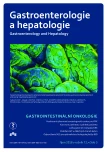Comparison of sulfate-based solution and polyethylene glycol solution for bowel cleansing before colonoscopy – randomized, single-blind study
Authors:
K. Kmochová 1; T. Grega 1; G. Vojtěchová 1
; O. Ngo 2; O. Májek 2; M. Zavoral 1; Š. Suchánek 1
Authors‘ workplace:
Interní klinika 1. LF UK a ÚVN VFN, Praha
1; Institut biostatistiky a analýz LF MU, Brno
2
Published in:
Gastroent Hepatol 2018; 72(5): 397-400
Category:
Gastrointestinal Oncology: Original Article
doi:
https://doi.org/10.14735/amgh2018397
Overview
Background:
Adequate bowel cleansing is a fundamental requisite for proper colonoscopy examinations. Among bowel preparations, polyethylene glycol (PEG) is the gold standard, but requires large volumes of solution. Low-volume preparations could provide an alternative to PEG. A Czech randomized single blind study compared the efficiency of a low-volume sulfate-based solution (SBS) with that of PEG.
Aim:
To compare the quality of bowel cleansing and detection of colorectal neoplasia after cleansing with SBS and PEG solutions.
Method:
Individuals who had undergone colonoscopy screening in a single tertiary endoscopic center were enrolled in this randomized single-blind study. All individuals were consistently educated about the split dose regimen. The quality of bowel cleansing was evaluated by endoscopists who were blinded to the type of bowel preparation. The effectiveness of bowel preparation was assessed by the degree of bowel cleansing (modified Boston scale, levels A–D) and by the detection rate of colorectal neoplasia.
Results:
In the period May 2015 to June 2016, 462 individuals were included in the study. PEG was employed in 233. SBS was employed in 229. Bowel cleansing by SBS and PEG was similar (PEG 97% vs. SBS 94%; p = 0.197). However, quality of bowel cleansing was better with split dose bowel preparation (PEG 97 vs. 93%, p = 0.263; SBS 96 vs. 81%, p = 0.006). A significant difference was observed between split dose and single dose preparations in the SBS group (PEG 70 vs. 59%, p = 0.284; SBS 75 vs. 28%, p < 0.001). Detection of colorectal neoplasia was comparable between the two groups: adenoma (PEG 39 vs. 44%; p = 0.346), advanced adenoma (6% PEG vs. 7% SS; p = 1.000), and carcinoma (0.4% PEG vs. 0.4% SS). Conclusion: A low-volume solution of sulfate salts is as effective as PEG for colon screening by colonoscopy.
Key words:
quality of bowel cleansing – colonoscopy – quality of colonoscopy – detection of colorectal neoplasia
The Editorial Board declares that the manuscript met the ICMJE „uniform requirements“ for
The authors declare they have no potential conflicts of interest concerning drugs, products, or services used in the study.
Submitted: 19. 9. 2018
Accepted: 1. 10. 2018
Sources
1. Hassan C, Bretthauer M, Kaminski MF et al. Bowel preparation for colonoscopy: European Society of Gastroenterology (ESGE) guideline. Endoscopy 2013; 45 : 142–150. doi: 10.1055/s-0032-1326186.
2. Suchánek Š, Májek O, Grega T et al. Nová, efektivní a bezpečná střevní příprava. Practicus 2014; 13 (7): 15–19.
3. Rembacken B, Hassan C, Riemann JF et al. Quality in screening colonoscopy: position statement of the European Society of Gastrointestinal Endoscopy (ESGE). Endoscopy 2012; 44 (10): 957–968. doi: 10.1055/s-0032-1325686.
4. Falt P, Urban P, Vítek P et al. Koloskopie. Praha: Grada Publishing 2015 : 51–60.
5. Rex DK, Di Palma JA, Rodriguez R et al. A randomized clinical study comparing reduced-volume oral sulfate solution with standard 4-liter sulfate-free electrolyte lavage solution as preparation for colonoscopy. Gastrointest Endosc 2010; 72 (2): 328–336. doi: 10.1016/j.gie.2010.03.1054.
6. Park SS, Sinn DH, Kim YH et al. Efficacy and tolerability of split-dose magnesium citrate: low-volume (2 liters) polyethylene glykol vs. single-or split-dose polyethylene glykol bowel preparation for morning colonoscopy. Am J Gastroenterol 2010; 105 (6): 1319–1326. doi: 10.1038/ajg.2010.79.
7. Corporaal S, Kliebeuker JH, Koornstra JJ. Low-volume PEG plus ascorbic acid versus high-volume PEG as bowel preparation for colonoscopy. Scand J Gastroenterol 2010; 45 (11): 1380–1386. doi: 10.3109/00365521003734158.
8. Jansen SV, Goedhard JG, Winkens B et al. Preparation before colonoscopy: a randomized controlled trial comparing different regimes. Eur J Gastroenterol Hepatol 2011; 23 (10): 897–902. doi: 10.1097/MEG.0b013e32834a3444.
9. Rex DK, Di Palma JA, McGowan J et al. A comparison of oral sulfate solution with sodium picosulfate: magnesium citrate in split doses as bowel preparation for colonoscopy. Gastrointest Endosc 2014; 80 (6): 1113–1123. doi: 10.1016/j.gie.2014.05.329.
10. Di Palma JA, Rodriguez R, McGowan J et al. A randomized clinical study evaluating the safety and efficacy of a new, reduced-volume, oral sulfate colon-cleansing preparation for colonoscopy. Am J Gastroenterol 2009; 104 (9): 2275–2284. doi: 10.1038/ajg.2009.389.
11. Vepřeková G, Suchánek Š, Martínek J et al. Příprava střeva před kolonoskopií. Gastroent Hepatol 2012; 66 (1): 57–62.
Labels
Paediatric gastroenterology Gastroenterology and hepatology SurgeryArticle was published in
Gastroenterology and Hepatology

2018 Issue 5
- Metamizole vs. Tramadol in Postoperative Analgesia
- Current Insights into the Antispasmodic and Analgesic Effects of Metamizole on the Gastrointestinal Tract
- Spasmolytic Effect of Metamizole
- Metamizole at a Glance and in Practice – Effective Non-Opioid Analgesic for All Ages
- The Importance of Limosilactobacillus reuteri in Administration to Diabetics with Gingivitis
Most read in this issue
- Proton pump inhibitors in the light of clinical studies and the safety profile of long-term use
- Self-expanding duodenal stents, palliative treatment of gastric outlet obstruction in malignant disease
- Laparoscopic pancreaticoduodenectomy for ampullary adenocarcinoma – a case report
- Pancreatic cancer from the patients’s point of view
